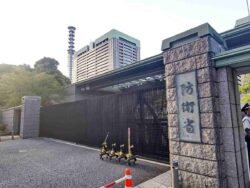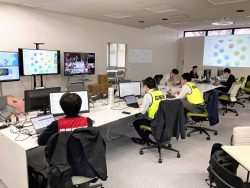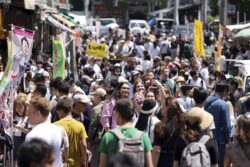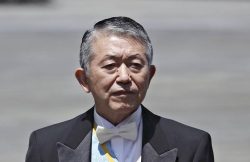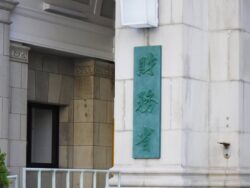China Intensifies Strategy to Block U.S. Intervention in Case of Conflict in Taiwan or South China Sea
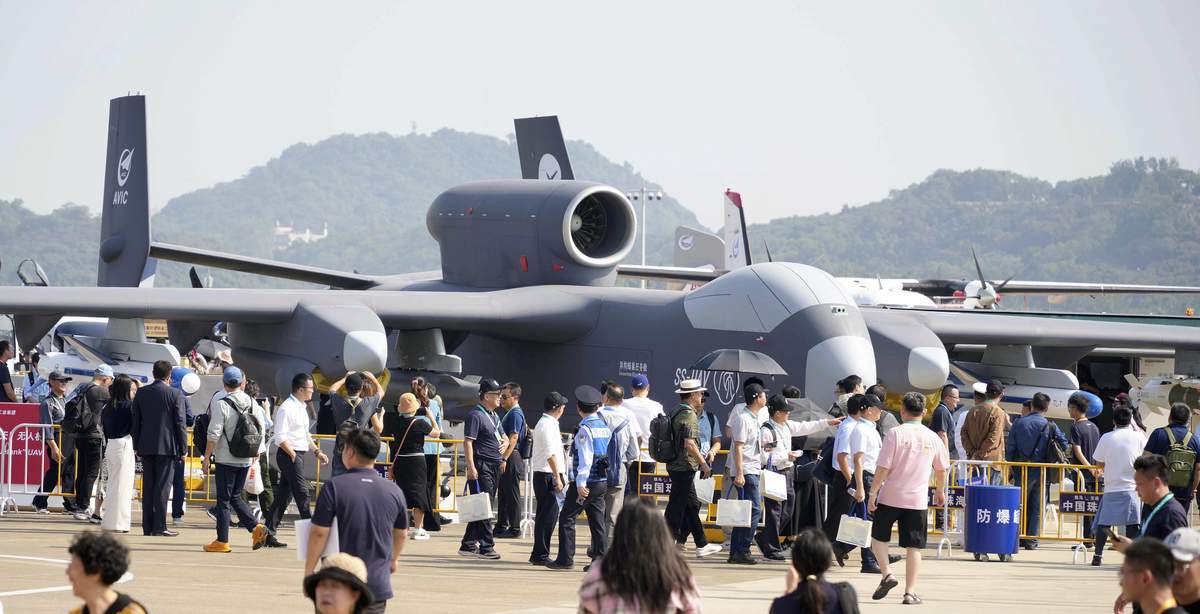
A large transport drone is displayed at the China International Aviation and Aerospace Exhibition in Guangdong Province, China, in November.
1:00 JST, April 4, 2025
China’s increased deployment of drones in the airspace around the Nansei Islands that span Kyushu and Okinawa Island is seen as part of its anti-access/area denial (A2/AD) strategy aimed at challenging U.S. military power.
A2/AD is a Chinese military strategy to prevent U.S. military intervention in the event of a conflict in Taiwan or the South China Sea.
It seeks to impede U.S. movement between the first island chain, which stretches from the Nansei Islands to the Philippines, and the second island chain, which stretches from the Ogasawara Islands to Guam, where U.S. bases are located, and to deny access within the first island chain, which is closer to China.
China’s heightened operational capabilities for drones pose a critical security threat to Japan, necessitating the immediate implementation of new countermeasures by the Defense Ministry.
Expansion of drone activities
A government official expressed concern, saying, “China is believed to keep Japan and the United States in check by enhancing its drone operational capabilities, with a focus on a potential invasion of Taiwan.”
Chinese drones primarily utilize two routes between the East China Sea and the Pacific Ocean: the Okinawa Island-Miyako Island route and the Yonaguni Island-Taiwan route. In fiscal 2022, activity was concentrated on the Okinawa Island-Miyako Island route, while in fiscal 2023, coinciding with the Taiwan presidential election, drone activity shifted exclusively to the Yonaguni Island-Taiwan route.
Fiscal 2024 saw a surge on both routes, with China significantly expanding its activity in the Pacific.
On June 4 last year, a Chinese TB001 strike and reconnaissance unmanned aerial vehicle crossed the Okinawa Island-Miyako Island passage, entered the Pacific Ocean and then headed north, making its first appearance east of Amami-Oshima Island in Kagoshima Prefecture.
Similar incidents occurred three times in late February, indicating accelerating Chinese military activity to the east of the first island chain, which China considers a crucial line of defense.
Some of the drones identified were models capable of carrying missiles.
A2/AD strategy
A major concern is China’s drone reconnaissance capabilities. China possesses the Dong-Feng 21 (DF-21D) ballistic missile, which has a range of 2,150 kilometers and is known as a “carrier killer.”
Accurately targeting a moving ship at sea requires precise positioning and missile guidance. However, Earth-orbiting reconnaissance satellites cannot provide continuous tracking of a ship’s movements between their passes.
“It’s a significant threat if drones can locate ships and guide missiles based on this information,” a Japanese government official said.
There was also a reported incident last fiscal year in which a Chinese drone flew near a U.S. aircraft carrier as it was sailing along the Pacific coast of the Nansei Islands.
China has not ruled out the use of force to unify Taiwan with China.
“In the event of a contingency, China envisions using drones and other means to block Self-Defense Forces coming from Japan and U.S. military ships and planes, so that it can create a division between the Nansei Islands and other parts of Japan,” said Keio University Prof. Jun Yasuda, an expert on Chinese military affairs.
Contrasting responses
The SDF is also being forced to take actions against Chinese drones.
In fiscal 2023, the Air Self-Defense Force conducted 669 scrambles against foreign aircraft suspected of violating Japanese airspace, about four times the 158 scrambles in fiscal 2003, indicating a sustained high level of such activity. About 70% of these scrambles were directed toward Chinese aircraft, including drones.
Unlike drone activities, which carry no risk to human life, ASDF fighter jet activities expose pilots to danger.
In 2023, the Japanese government eased restrictions on the use of weapons against drones. This policy change allows for the use of weapons against drones that have violated Japanese airspace and are headed toward critical facilities such as airports or nuclear power plants.
“In the future, the use of drones in response to airspace incursions will also be considered,” Yoshihide Yoshida, chief of staff of the Joint Staff, said at a regular press briefing in March.
"Politics" POPULAR ARTICLE
-

Japan to Support Central Asian Logistics Route That Bypasses Russia, Plan to Be Part of Upcoming Summit in Tokyo
-

Japan to Tighten Screening of Foreigners’ Residential Status by Providing Information of Nonpayment of Taxes
-

Takaichi Cabinet Approval Holds at 72% as Voters Back Aggressive Fiscal Stimulus, Child Benefits
-
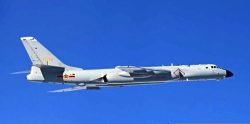
Chinese, Russian Bombers Flew Unusual Path by Heading Toward Tokyo; Move Likely Meant to Intimidate Japan
-

Takaichi Meets Many World Leaders at G20 Debut in Johannesburg; Speaks with Heads of Countries Including Italy, U.K., Germany, India
JN ACCESS RANKING
-

Keidanren Chairman Yoshinobu Tsutsui Visits Kashiwazaki-Kariwa Nuclear Power Plant; Inspects New Emergency Safety System
-

Imports of Rare Earths from China Facing Delays, May Be Caused by Deterioration of Japan-China Relations
-

University of Tokyo Professor Discusses Japanese Economic Security in Interview Ahead of Forum
-
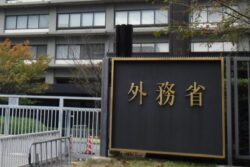
Japan Pulls out of Vietnam Nuclear Project, Complicating Hanoi’s Power Plans
-

Govt Aims to Expand NISA Program Lineup, Abolish Age Restriction


